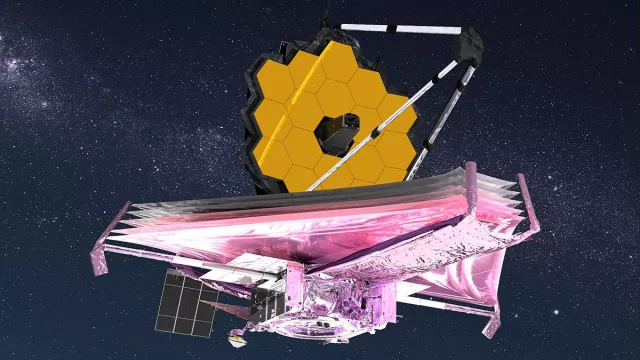MIRI is an infrared instrument on the James Webb Space Telescope (JWST), acquiring images in a range of wavelengths from 5 to 28 microns.
Key information
Key figures
- 6,200 kg: mass of space telescope
- 4 instruments
- 6.5 metres: diameter of primary mirror
- 5 to 28 micrometres: range of observed wavelengths
Key milestones
- 25 December 2021: JWST launched by Ariane 5 ECA
- End 2016: Assembly of JWST
- 2009: Construction of JWST elements gets underway
- End 2008: Transition to phase C of development
- September 2002: Telescope named James Webb Space Telescope
- 2002: Transition to phase B of development
- 1995: Transition to phase A of development
- 1995: NASA extends mission of Hubble Space Telescope to 2005
- 1989 to 1994: Studies begin to develop successor to Hubble Space Telescope
Project in brief
MIRI (Mid InfraRed Instrument) is a scientific instrument aboard the new James Webb Space Telescope (JWST), alias Webb. JWST is the successor to the Hubble Space Telescope, launched in 1990. But unlike its forerunner operating in the visible and ultraviolet portions of the light spectrum, Webb is designed to analyse infrared radiation. It’s also considerably more powerful than Hubble, enabling it to observe even more-distant and therefore more-ancient objects. With Webb, it’s now possible to view the first galaxies that formed in the universe, and even to witness their birth. The giant telescope is also observing many other objects such as galaxies and exoplanets in detail, and looking inside their atmospheres.
There are four instruments on Webb: MIRI (Mid-InfraRed Instrument), NIRISS (Near-InfraRed Imager and Slitless Spectrograph), NIRCam (Near-InfraRed CAMera) and NIRSpec (Near-InfraRed SPECtrograph)
MIRI was developed under the lead of ESA and national space agencies by a consortium of European laboratories working with NASA’s Jet Propulsion Laboratory (JPL). It is the result of a collaboration between the United Kingdom (PI), France, Germany, Belgium, Denmark, Spain, Ireland, Netherlands, Sweden and Switzerland.
MIRI consists of two main parts: spectrometers developed by the Netherlands and the United Kingdom, and the MIRIM imager developed in France under CNES’s responsibility by the French atomic energy and alternative energies commission CEA, the LESIA space and astrophysics instrumentation research laboratory in Meudon, the LAM astrophysics laboratory in Marseille and the IAS space astrophysics institute in Orsay.
MIRI features four observing modes: imaging, coronagraph, low-resolution spectroscopy and medium-resolution integral field spectroscopy. The first three of these are performed by MIRIM (Mid-InfraRed IMager)
The Webb mission is led by NASA in partnership with the Canadian Space Agency (CSA) and the European Space Agency (ESA), which provided the Ariane 5 launch vehicle. Working with its partners, ESA was responsible for developing and qualifying adaptations to Ariane 5 required to launch Webb, and for launch services through Arianespace. It also supplied the NIRSpec instrument and 50% of the MIRI instrument.
With its improved performance, Webb hopes to see the “first light” of the universe, i.e., it’s going to survey the sky approximately 13½ billion years in the past. It also has the capability to observe the formation of stars in molecular clouds and of solar systems around other stars, and to see planets similar to or larger than Jupiter around stars.
Unlike Hubble, Webb is not in orbit around the Earth, but around the L2 Lagrange point of the Earth-Sun system.
CNES’s role
CNES oversaw development of the MIRI instrument’s MIRIM imager in partnership with the prime contractor CEA, with contributions from the LESIA space and astrophysics instrumentation research laboratory, the LAM astronomy laboratory in Marseille and the IAS space astrophysics institute.
Contacts
JWST/MIRI Project Leader
Desi Raulin
E-mail: desi.raulin at cnes.fr
Astronomy & Astrophysics subject matter expert
Philippe Laudet
E-mail: philippe.laudet at cnes.fr
Head of Universe Sciences
Olivier Lamarle
E-mail: Olivier.lamarle at cnes.fr


